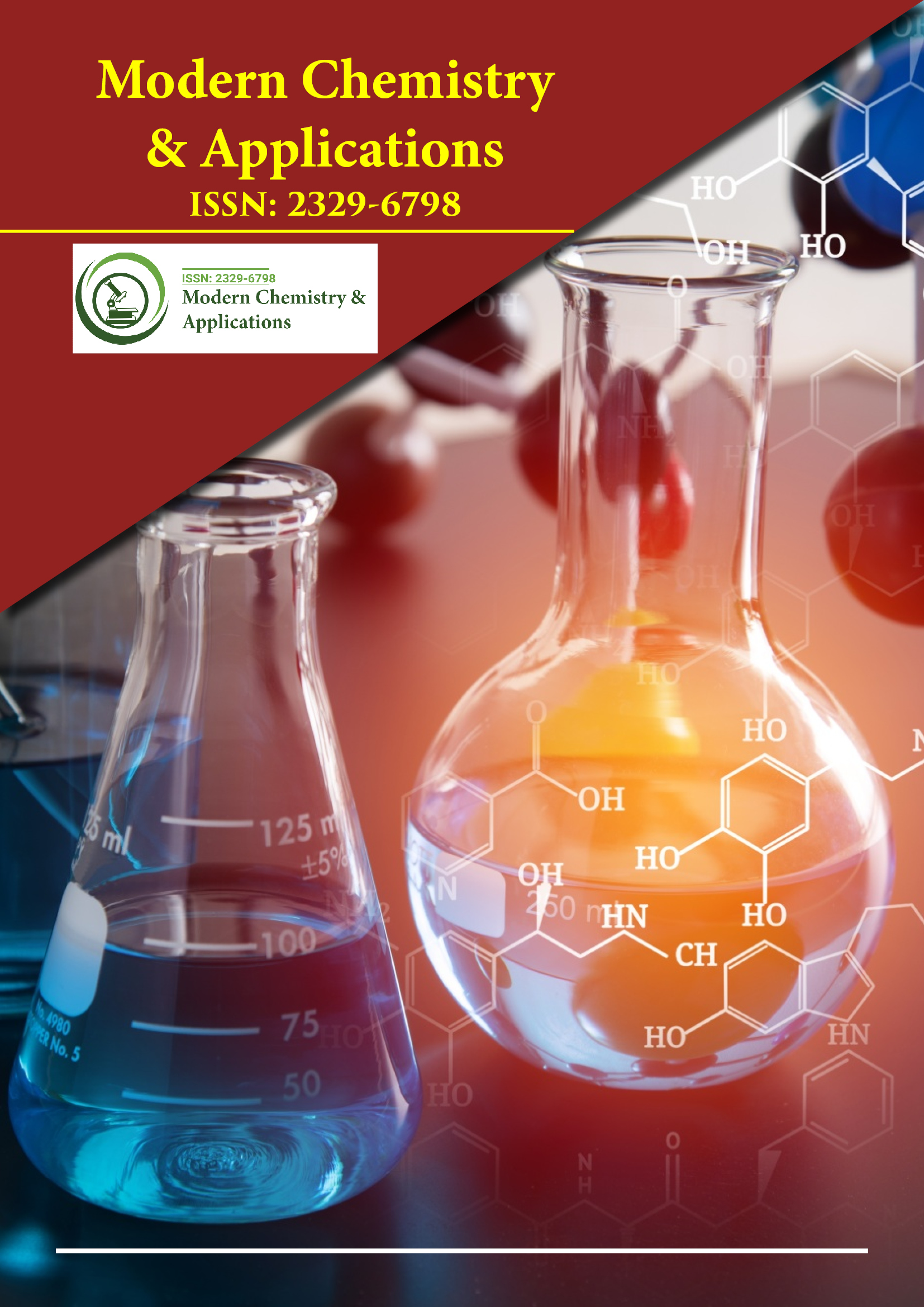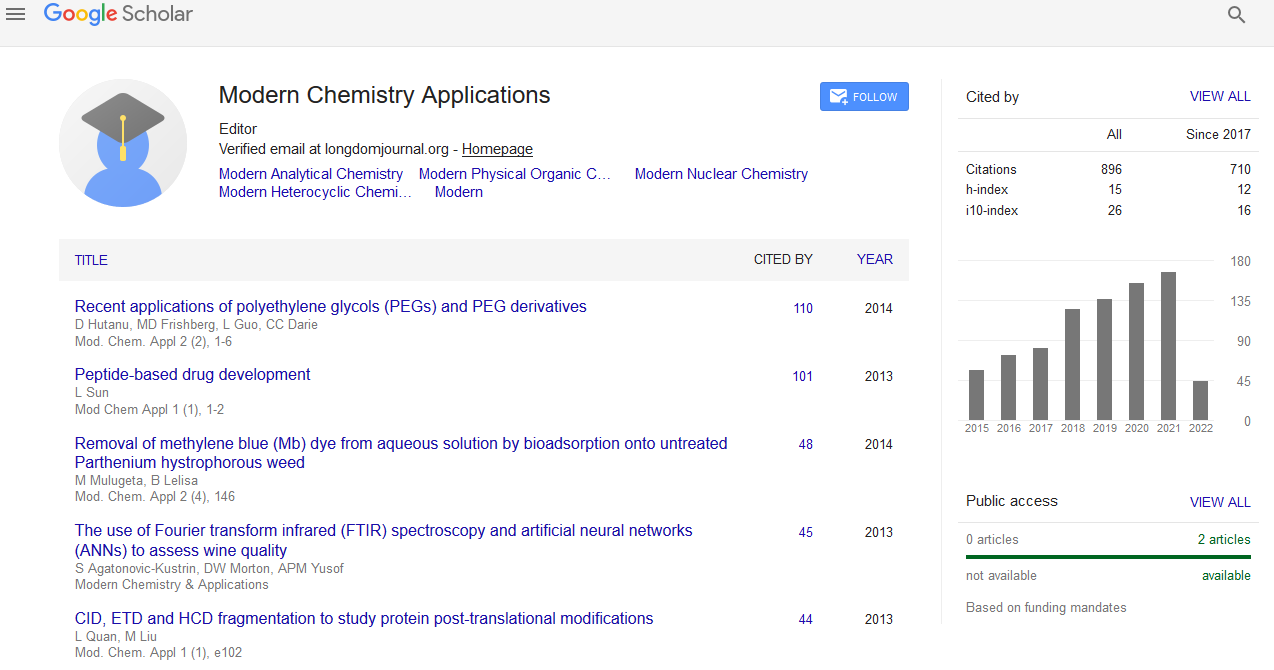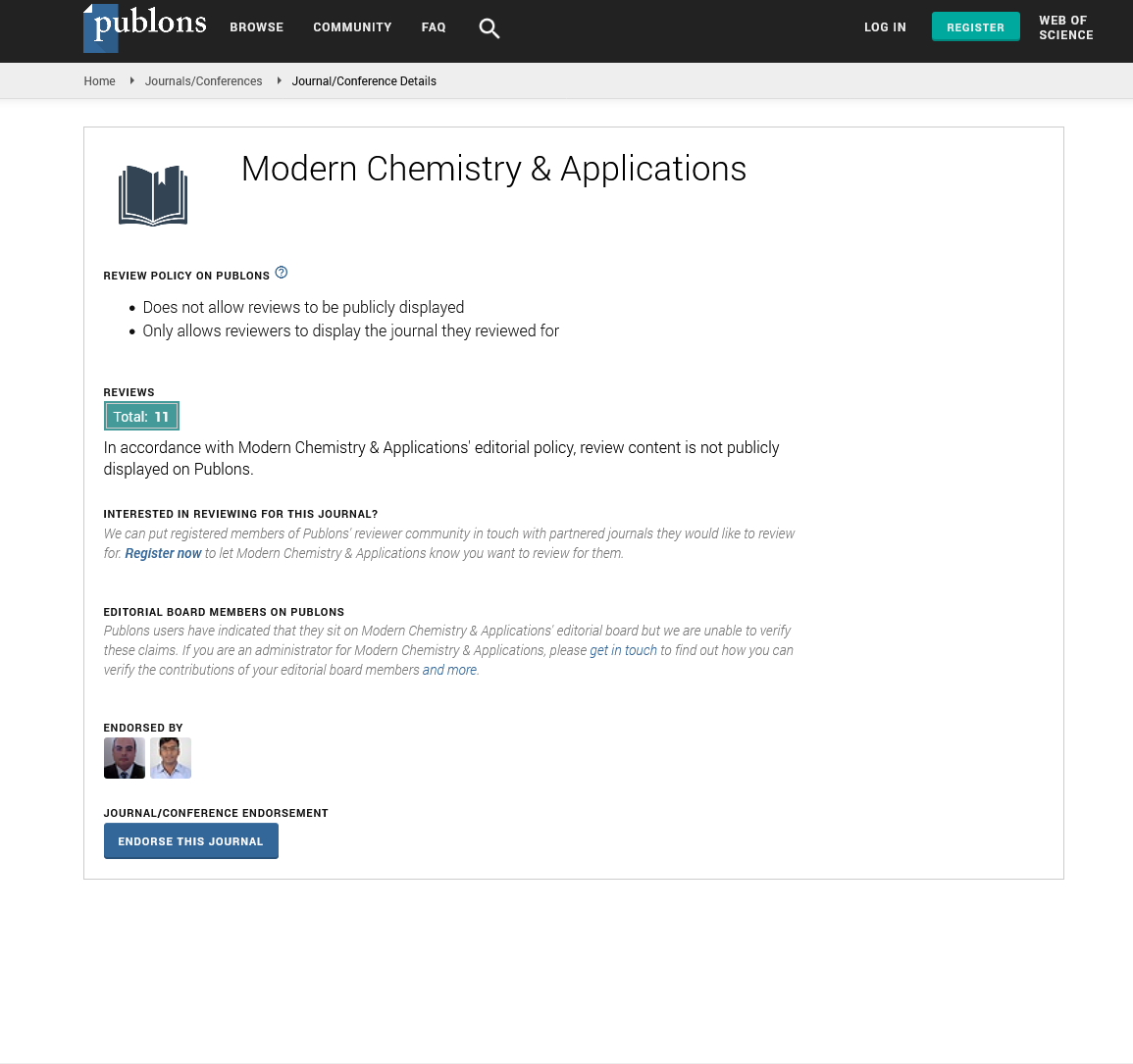Indexed In
- Open J Gate
- JournalTOCs
- RefSeek
- Hamdard University
- EBSCO A-Z
- OCLC- WorldCat
- Scholarsteer
- Publons
- Geneva Foundation for Medical Education and Research
- Google Scholar
Useful Links
Share This Page
Journal Flyer

Open Access Journals
- Agri and Aquaculture
- Biochemistry
- Bioinformatics & Systems Biology
- Business & Management
- Chemistry
- Clinical Sciences
- Engineering
- Food & Nutrition
- General Science
- Genetics & Molecular Biology
- Immunology & Microbiology
- Medical Sciences
- Neuroscience & Psychology
- Nursing & Health Care
- Pharmaceutical Sciences
Opinion Article - (2025) Volume 13, Issue 1
Exploring the Future of Chemistry Through Modern Applications
Oliver Bennett*Received: 26-Feb-2025, Manuscript No. MCA-25-29061; Editor assigned: 28-Feb-2025, Pre QC No. MCA-25-29061 (PQ); Reviewed: 14-Mar-2025, QC No. MCA-25-29061; Revised: 21-Mar-2025, Manuscript No. MCA-25-29061 (R); Published: 28-Mar-2025, DOI: 10.35248/2157-7560.25.13.489
Description
Chemistry continues to evolve as new challenges and technologies reshape scientific priorities. It no longer exists solely within academic laboratories or industrial production lines; instead, it influences sectors as varied as healthcare, energy, agriculture and environmental science. By adapting to current needs and integrating knowledge from related disciplines, modern chemistry is expanding its practical reach and offering new tools for addressing global concerns.
One key area of application is healthcare. The development of pharmaceuticals relies heavily on chemical principles, from drug synthesis to formulation and delivery. Advances in molecular design have led to more selective and effective treatments for conditions that were previously difficult to manage. Chemists work alongside biologists and medical professionals to understand how compounds interact with the body, enabling the creation of agents that can reach specific targets while minimizing side effects. Nanotechnology, for example, allows delivery systems to carry drugs to precise locations, improving efficiency and reducing dosage requirements.
Another field benefiting from chemical research is renewable energy. Scientists are continually developing materials and processes to support clean energy production, storage and conversion. Solar panels, fuel cells and advanced batteries are all products of materials chemistry. The search for stable, abundant and low-cost alternatives to traditional materials is ongoing, with attention focused on performance, durability and recyclability. As energy demand continues to rise, such developments are critical for reducing reliance on limited resources.
In agriculture, chemistry contributes to both productivity and sustainability. The development of fertilizers, herbicides and pesticides has long been central to improving crop yields. Today, the focus is shifting toward more environmentally conscious solutions. Researchers are working on biodegradable compounds, precision application systems and methods that improve nutrient absorption while minimizing runoff into water systems. Soil chemistry is also being explored in greater depth to understand how minerals, organic matter and microbes interact to influence plant growth.
Environmental protection is another major focus for modern chemistry. Waste treatment, water purification and air quality monitoring all depend on chemical processes. Chemists are creating filters, catalysts and sensors that can detect and remove pollutants more effectively. Advances in analytical chemistry allow for the detection of contaminants at extremely low levels, helping regulatory agencies set safety standards and enforce compliance. Chemical methods are also used to assess environmental damage and support cleanup efforts after industrial accidents or natural disasters.
Materials development is a further area that demonstrates the adaptability of chemical science. Polymers, ceramics and composites are designed with specific properties for use in electronics, aerospace, construction and textiles. These materials must meet precise performance requirements such as strength, conductivity, thermal stability and resistance to wear. The creation of such compounds often requires careful control of molecular structure, synthesis conditions and processing techniques.
Chemical education and communication have also undergone changes in response to modern needs. With more industries relying on chemistry, there is greater demand for professionals with practical knowledge and interdisciplinary skills. Educational programs are incorporating digital tools, virtual labs and real-world problem solving to better prepare students. Public understanding of chemical science is also improving, aided by outreach efforts and media coverage that explain how everyday products and services are influenced by chemical research.
Digital technologies, including machine learning and automation, are being used more frequently in laboratories. These tools help accelerate discovery, improve accuracy and reduce manual work. Automated synthesis platforms can test multiple reactions simultaneously and computer models can predict how molecules will behave under various conditions. This integration of digital systems into chemical research makes experimentation more efficient and broadens the scope of what can be explored.
Another trend is the increased focus on sustainability and circular economy principles. Chemists are developing methods to reuse and recycle materials, reduce waste in production and design products with their entire life cycle in mind. This approach seeks to balance performance with environmental responsibility. For example, designing packaging that degrades under natural conditions or manufacturing processes that rely on renewable feedstocks are becoming priorities across industries.
Collaboration among different disciplines is now a standard practice. Chemists work with physicists, engineers, computer scientists and economists to develop solutions that are both technically feasible and economically viable. This exchange of knowledge allows chemical research to have wider impact and ensures that scientific advances are translated into practical outcomes.
Looking forward, chemistry will continue to influence how societies address their needs. Whether in advancing healthcare, improving living standards, or protecting natural resources, chemical science plays an essential role in shaping a future that is safer, more efficient and more sustainable. By adapting its methods and objectives, chemistry continues to remain relevant in a changing world.
Citation: Bennett O (2025). Exploring the Future of Chemistry Through Modern Applications. Modern Chem Appl. 13:489.
Copyright: © 2025 Bennett O. This is an open access article distributed under the terms of the Creative Commons Attribution License, which permits unrestricted use, distribution and reproduction in any medium, provided the original author and source are credited.


